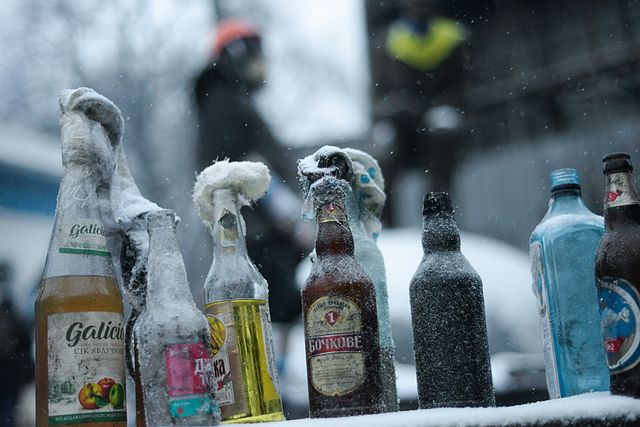
Who was Molotov and why was the Molotov cocktail named after him? He was Vyacheslav Molotov, Minister of Foreign Affairs in the Soviet Union
A Molotov cocktail is usually a bottle full of a flammable fuel with a fuse that is thrown by hand. They have become very famous because they are very easy to make and extremely effective. The fuel is usually gasoline, and the fuse is a slow burning cloth also soaked in gasoline that is pushed into the bottle and kept in place with the cork or cap of the bottle. The bottle is thrown and when it smashes, the fuel vaporizes on contact with the air. The fuse lights the fuel vapor, and it burns rapidly, expanding and causing an explosion.
The Molotov cocktails only got their name in World War 2, but they had been in use for a few years before that. The idea of a petrol bomb was thought up during the Spanish Civil War, between July 1936 and 1939. Specifically, they were first used in the Battle of Seseña, on October 29th, 1936. The Spanish Civil War was technically a war between the Spanish Republicans and Nationalists, but it ended up being a rehearsal for World War 2 because several other countries joined in on each side. The Nationalists were led by General Franco, who would go on to be dictator for close on forty years, and they were supported by Italy, Nazi Germany, and Portugal. The Republicans were supported by Mexico and Russia.
At the Battle of Seseña, the Republicans attacked the town with 15 new Soviet tanks. The attack ultimately failed and the Nationalists managed to destroy 3 tanks and damage 3 more by using petrol bombs. They used jam jars filled with about 1 liter of petrol and strips of heavy curtain as a fuse. They threw the petrol bombs in front of the advancing tanks and the burning petrol melted the rubber wheels that the tank’s tracks ran on.
So, who was Molotov and why was the Molotov cocktail named after him? The name Molotov cocktail comes from Finland. From 1323 until 1809, Finland was not a country. It was just a part of Sweden. Between 1808 and 1809, Sweden fought a war with Russia that they lost. The Russians took Finland, and it became part of the Russian Empire. After the Russian Revolution in 1917, Finland saw the opportunity to become an independent country. They declared independence and Lenin recognized it to show that his new government believed in fairness and national self-determination.
Before World War 2 broke out, Stalin and Hitler made a pact to partition Europe. Hitler would take Poland and Stalin would take Finland. The pact might have been worked out by Stalin and Hitler, but it bore the names of the foreign ministers of each country: Molotov and Ribbentrop. On November 30th, 1939, Russia invaded Finland, starting the Winter War. Russia managed to gain 9% of Finnish territory by the time the war ended in 1940, but the Finnish inflicted severe losses on the much larger Russian army. This pyrrhic victory was one of the reasons Hitler believed he could safely invade the Soviet Union.
Russian planes bombed Finland during the war, but Molotov lied on public radio and said the Russian planes were dropping humanitarian aid and food because international opinion was that Russia’s invasion was illegal. The Finns decided to make a joke of their own and started calling the petrol bombs they were using against Russian tanks Molotov picnic baskets. Soon, Finland’s vodka and liquor factories were repurposed to make the petrol bombs, and people started saying, “have a drink with the Molotov picnic basket.” It wasn’t long before they became known as “Molotov cocktails”.
The Finns produced close to half a million of these Molotov cocktails during the Winter War. They refined them by adding tar to the gasoline to make it sticky. Britain took up the idea of the Molotov cocktail a few years later when there was a strong possibility that Hitler would invade the UK. 6 million cocktails were produced and passed out to the Home Guard and local communities. They melted rubber into the fuel to make it stick even more and they worked out that the best quantity of fuel in the bottle to give the greatest explosion.
Throughout the war, Molotov cocktails were used by many other resistance groups. Since the war, they have often been the go to for revolutions and civil war because they are cheap, easy to make, and incredibly effective. So, why was the Molotov cocktail named after Molotov? It was to make a point about the Russians bombing the Finns under the guise of dropping aid. And this is what I learned today.
Sources
https://en.wikipedia.org/wiki/Molotov_cocktail
https://en.wikipedia.org/wiki/Battle_of_Sese%C3%B1a
https://en.wikipedia.org/wiki/Vyacheslav_Molotov
https://www.livescience.com/molotov-cocktails-history
https://www.nationalgeographic.com/history/article/history-of-the-molotov-cocktail
